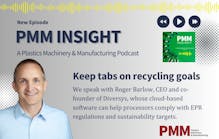NPE Booth S35185
Autosort Tomra’s sorting system for recycling has a flexible sensor configuration, using traditional near-infrared, visual spectrometry or other sensors. Material identification capabilities can include spotting previously undetectable fractions like black polymers.
What’s new? Upgrades to Tomra’s Gain package, which was first introduced for use with the Autosort in 2019. The rebranded technology — now known as GainNext — uses artificial intelligence (AI)-based deep learning technology to improve the Autosort’s performance. Recent upgrades allow it to separate food-grade from non-food-grade plastics for PET, PP and HDPE; it also has a software application to ensure higher-purity PET bottle streams.
Benefits Waste-stream purity of about 95 percent, according to Tomra. Sorting non-food-grade from food-grade plastics at scale to preserve the purity of food-grade recovered material has previously been difficult because the different packages often are made from the same material. The integrated, deep-learning AI software enables the system to adapt to future demands, Tomra says.
Tomra Sorting Inc., Charlotte, N.C., 980-279-5650, www.tomra.com/en/sorting/recycling
Ron Shinn | Editor
Editor Ron Shinn is a co-founder of Plastics Machinery & Manufacturing and has been covering the plastics industry for more than 35 years. He leads the editorial team, directs coverage and sets the editorial calendar. He also writes features, including the Talking Points column and On the Factory Floor, and covers recycling and sustainability for PMM and Plastics Recycling.






